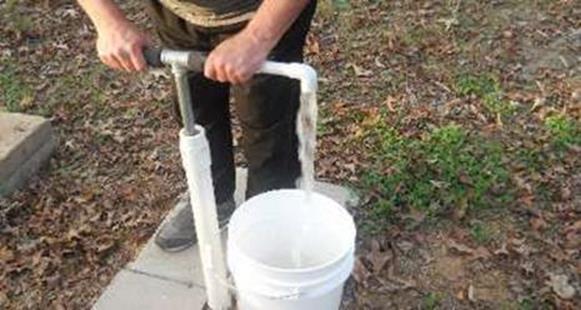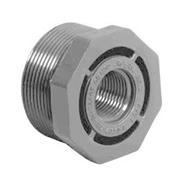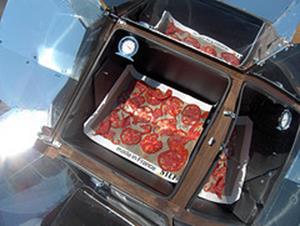Tear Gas
The first thing to remember about exposure to these chemical weapons is that it is not the worst thing that could happen to you. The hype and fear surrounding them is enormous, but in reality, if you are careful and smart, you should survive it with little problem. This information is the result of conversations with experts and prior experience.
1. How They Are Deployed:
Tear gas and pepper spray can be sprayed from small hand-held dispensers or large fire-extinguisher size tanks. Pepper spray also comes in plastic projectiles which are fired at the chest to knock the wind out of a person, who then takes a deep breath of pepper from the burst projectile. Tear gas is most commonly deployed via canisters, which are fired into crowds, sometimes directly at people. It’s important that you know not to pick up the canisters without gloves as they are extremely hot. Be aware that the time it takes you to throw it will allow you to be heavily exposed.
2. How They Affect Humans:
Both tear gas and pepper spray are skin irritants, causing burning pain and excess drainage from eyes, nose, mouth and breathing passages. Pepper spray is more popular with authorities as an agent of control because of its immediate pain-causing qualities. It is harder to remove from the skin and has the capacity to cause first degree burns.
If you are exposed to either tear gas or pepper spray, you may experience:
- Stinging, burning in your eyes, nose, mouth and skin
- Excessive tearing, causing your vision to blur
- Runny nose
- Increased salivation
- Coughing and difficulty breathing
- Disorientation, confusion and sometimes panic
- Intense anger from pepper spray exposure is a common response; this can be useful if you are prepared for it and are able to focus it towards recovery and returning to the action. Channel your anger, release it from your system, avoid holding it in.
The good news is that the above effects are temporary.
Discomfort from tear gas usually disappears after 5-30 minutes, while the worst pepper spray discomfort may take 20 minutes to 2 hours to subside. The effects of both diminish sooner with treatment. Because pepper spray penetrates to the nerve endings, its effects may last for hours after removal from the skin.
3. Avoid Inaccurate & Dangerous Treatment Myths:
There are many myths about treatment and prevention. Much of this misinformation is potentially dangerous. Some of it, if applied, could greatly increase or prolong a person’s reaction to exposure, or at the very least provide a false sense of security.
4. When to Prevent Exposure:
For most healthy people, the effects of tear gas and pepper spray are temporary. However, for some people the effects can be long-lasting and life-threatening.
People with the conditions listed below should be aware of these risks and may want to try and avoid exposure. Please be aware that in intense actions such as police behavior can be unpredictable, and avoidance is not always possible. Those with the following health conditions should avoid entering crowds where there is risk of exposure to these substances.
Conditions:
- Folks with respiratory diseases, such as asthma, emphysema, etc. risk exacerbation, or permanent damage if exposed.
- Vulnerable people such as infants, the elderly, and the immune compromised, risk intensified and possibly life-threatening responses.
- Anyone with chronic health conditions or those on medications that weaken the immune system, (ie: chemotherapy, Lupus, HIV, radiation, or long-term corticosteroids such as prednisone) risk exacerbation of illness, intensified response and possible delayed recovery.
- Women who are or could be pregnant, or who are trying to get pregnant, may be at risk of spontaneous abortion, or increased risk of birth defects.
- Nursing mothers risk passing toxins on to their infant.
- Folks with skin conditions (ie: severe acne, psoriasis, or eczema) and eye conditions (i.e.: conjunctivitis or uveitis) risk an intensified response.
- People wearing contact lenses may experience increased eye irritation and damage due to chemicals being trapped under the lenses.
5. Protection:
- Avoid the use of oils, lotions and detergents because they can trap the chemicals and thereby prolong exposure. Wash your clothes, your hair and your skin beforehand in a detergent-free and unscented soap.
- We recommend using a water or alcohol-based sunscreen (rather than oil-based). If your choice is between oil-based or nothing, we advocate using the sunscreen. Getting pepper sprayed on top of a sunburn is not fun.
- We also recommend minimizing skin exposure by covering up as much as possible. This can also protect you from the sun, as can a big hat, baseball cap or bandana.
- Gas masks provide the best facial protection, if properly fitted and sealed. Alternatively, swimming goggles (with shatter-proof lenses), respirators, even a wet bandana soaked in vinegar over the nose and mouth will help.
6. What to Do When Exposed:
- STAY CALM. Panicking increases the irritation. Breathe slowly and remember it is only temporary. Educate yourself prior to going out, to know what to expect, and thereby reduce the likelihood of panicking.
- If you see it coming or get a warning, put on protective gear, if able, try to move away or get upwind.
- Blow your nose, rinse your mouth, cough and spit repeatedly. AVOID SWALLOING.
- If you wear contacts, try to remove the lenses or get someone to remove them for you, with CLEAN, uncontaminated fingers. AVOID WEARING CONTACT LENSES BEFORE GOING OUT.
- DO NOT RUB IT IN.
7. Remedies
We have been doing trials with pepper spray to find good remedies and have found some things will definitely help minimize the discomfort. None of these are miracle cures; using these remedies will help people to feel better faster, but it will still take time.
For the eyes and mouth:
We recommend a solution of half liquid antacid (like Maalox) and half water. A spray bottle is ideal but a bottle that has a squirt cap works as well. Always irrigate from the inside corner of the eye towards the outside, with head tilted back and slightly towards the side being rinsed. It seems from our trials that it needs to get into the eye to help. This means that if the sprayed person says it’s okay you should try to open their eye for them. They most likely won’t be able/willing to open it themselves, and opening will cause a temporary increase in pain, but the solution does help. It works great as a mouth rinse too.
For the skin:
We recommend canola oil followed by alcohol. Carefully avoiding the eyes, vigorously wipe the skin that was exposed to the chemical with a rag or gauze sponge saturated with canola oil. Follow this immediately with a rubbing of alcohol. Remember that alcohol in the eyes hurts A LOT. Anyone whose eyes you get alcohol in will not be your friend.
Secondary treatments can include: spitting, blowing your nose, coughing up mucous (you don’t want to swallow these chemicals!), walking around with your arms outstretched, removing contaminated clothing and putting on new clothing, In fact, it is essential to shower and wash your clothes as soon as you are able.
WARNING: pepper spray can dry on your skin, and then get re-activated when you shower due to contact with moisture! See section below on how to get rid of pepper spray before you shower!
These chemicals are toxic, and will continually contaminate you and everyone around you until you get rid of it. Until then, try not to touch your eyes or your face, or other people, furniture, carpets etc. to avoid further contamination. Also rinse your washing machine in highest heat after you wash your clothes in them, to get rid of residue inside the machine.
Remember, it is only temporary, and our bodies are extremely strong and have detoxification mechanisms built in
8. Essential Protective Gear:
A bandanna soaked vinegar and tied tightly around the nose and mouth is a last resort. It is far better than nothing, but remember that it is merely a barrier and not a filter and so won’t do much for long-term protection. You can keep it soaking in a plastic bag until ready to use. Bring several, as multiple uses will render a bandanna as gassy as the air around you.
For protecting your eyes, swim goggles work well as they have a tight seal. Shatter-resistance is another nice quality for goggles to have. Most goggles have air holes to prevent fogging–fill these with epoxy (glue).
Covering these holes with duct tape can work in a pinch against an initial attack, though not for long term protection. Try them on with your respirator or bandana to ensure that they are compatible and that both will provide a tight seal.
You should be aware that whatever protection you choose will be visually quite powerful. Gas masks work the best; they also look quite scary and intimidating and can be alienating to others. They can however also make you a target of police violence. Think carefully about your impact on others when you decide how to protect yourself. Aim to wear the same kind of gear as a group, not just you as an individual. Strength in numbers.
We suggest that you trial your gear at home before you head out, to make sure you understand your protective mechanisms and are familiar with them, prior to entering the heat of action.
Here’s a tip I got from Palestinian demonstrators:
Smear lime fruit juice on the inside of any fabric which covers your mouth such as a scarf – anything you use to cover your mouth. This is claimed to remove all effects from the CS gas (tear gas) although I haven’t really tried it myself.
9. Improvised Gas Mask:
Find a bandana, or a rag: something to wrap around your head made of strong material.
Now find some charcoal. Smash up the charcoal. Soak the bandana/rag in water. Line one side of the bandana/rag with charcoal dust. Fold bandana/rag over and wrap around your nose and mouth.
10. Onions as Protection Against Tear Gas:
If you don’t have any vinegar or water-soaked bandanas, or may be around someone who doesn’t, carry an onion on you. If gassed, break it in half and sniff it, and get it close to your eyes….it greatly reduces the irritation in the eyes and nasal cavity. I Learned that from a photojournalist in Gaza.
Get each friend to carry an onion in their pocket before you head out.
11. How to Safely Get Rid of Pepper Spray – DO NOT APPLY WATER!
When dealing with OC sprays (Pepper Gas) you will find that they are activated and reactivated by water. In other words, even if you have let it dry on your skin you are still at risk to reactivation, if you were to get it wet again.
The safest way to remove contamination from the skin is to let the skin dry, dab with a dry cloth or fan the skin. Pending availability, products like baby shampoo can be applied to a contaminated area around eyes and face (it works even better if it is refrigerated prior to application) to provide temporary relief (also the drying of the shampoo will help remove a large amount of the loose capsaicin).
It’s not uncommon to feel unable to open your eyes.
When sprayed, I have found the quickest relief is to strobe your eyes to get tears flowing again. Once you can open your eyes and tear, stare for as long as you can bear letting the tears flow to clear your eyes as quickly as possible. The longer you keep your eyes shut and the longer you strobe your eyes the longer you will be contaminated. You want the body fluids in the mouth, nose and eyes to be running as much as possible (this is your bodies’ /body’s natural defense clearing itself out – work with it!).
What is capsaicin? From Wikipedia: Capsaicin is the active ingredient [derived from chilli peppers] in riot control and personal defense pepper spray chemical agents. When the spray comes in contact with skin, especially eyes or mucous membranes, it is very painful, and breathing small particles of it as it disperses can cause breathing difficulty, which serves to discourage assailants.
12. How to Safely Get Rid of Tear Gas – DO NOT APPLY WATER!
Do NOT wash your face with water if you suffer tear gas. You should not wet your skin: it increases the effect of the tear gas.
Instead, apply vinegar or lemon juice to the skin in order to get rid of the effect of the tear gas. Cloths with some apple vinegar or pure lemon juice are very useful in riots. You can press some lemon in a plastic bottle before going to the protest. So you can wet your mask with lemon juice (or vinegar), and it will decrease the effect of tear gas.
In case of old teargas
No water , yeast dissolved in water or cold water and soup while showering
13. How to Handle Tear Gas Canisters
The thick gloves used by construction workers are good to throw the tear gas cans back to the Basiji goons.
Warning: The tear gas cans are too hot to hold with bare hands!
14. Afterward, Wash Your Clothes As Soon As You Can
Wash your clothes as soon as possible because there are chemicals on those clothes!
Remember to eat well and sleep tight before going to a protest. If you smoke or take drugs, stop it before you go.
For your skin, a couple of boxes of Baking Soda will help in addition to regular soap with skin conditioners. Remember, the pepper spray is going to really get to your mucous membranes. Under your armpits, Crotch (sorry ladies, its going to burn like hell). The snot is going to pour out of your nose like someone turned on a fire hydrant and its going to burn the whole time. Your eye lids are going to swell up too. Use the Benadryl (Diphenhydramine hydrochloride ) for that.
If you eat tear gas, don’t use water – it makes everything worse. Use fresh lemon juice or vinegar instead.
15. Designed to Induce Panic – Stay Calm:
If you get hit by tear gas, or something worse, it will feel like you are unable to breathe. This is how it works, and is designed to work. You panic, and riots stop. The trick is to understand that while it feels like you are unable to breathe, you are actually breathing just fine. Tear gas doesn’t kill people unless they have a severe allergic reaction to it or have a medical condition/weakness already.
So try and remain calm. If you can, sit down in a place out of the way and just remind yourself that you are breathing. Getting rid of the panic eliminates a lot of the effectiveness of the anti-riot gas.
16. Conclusion:
Educate yourself about the tear gas and pepper spray challenge.
Print this page, and share it with all your friends. Stock up on cloths, goggles, vinegar/lemon juice, and water.
Some more info:
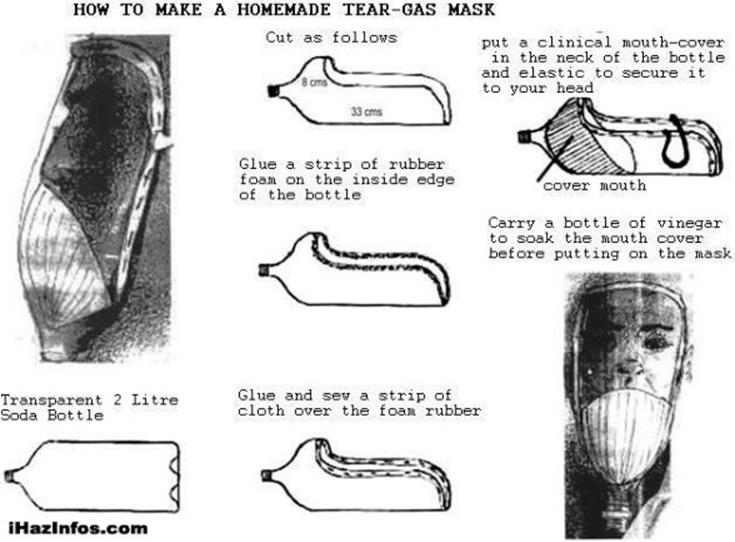
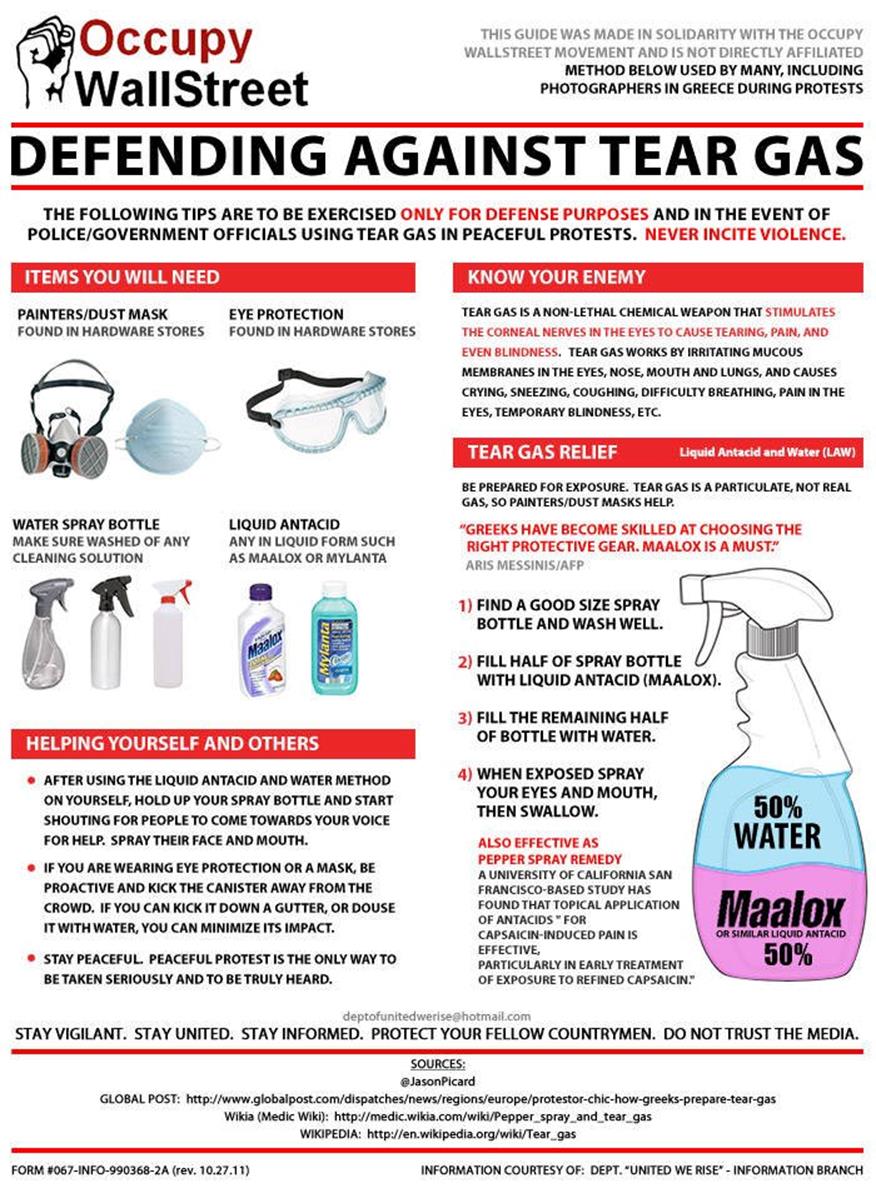
Tear Gas Dibenzoxazepine | CR GAS
Chemical weaponry was first used in the United States in the Civil War at the siege of Charleston. Wood was saturated with sulphur and burned under the parapets around the city hoping that favorable winds would propel huge clouds of choking smoke to drive out the defenders. French law enforcement is reputed to have been the first police organization to have used a chemical lachrymator (tear-producing) in a hand-thrown device. At the start of World War I (1914-1918) the French Army had limited stocks of hand and rifle grenades, loaded with a liquid tear-producing agent called Ethylbromacetate.
Agent CR (Dibenzoxazepine) is a potent sensory irritant. CR is the parent compound of Loxapine Succinate, an Anti-Psychotic drug. CR is usually disseminated in a liquid solution with a propylene glycol base. CRs physical properties are similar to those of CS, but CRs effects on the individual are more severe. In addition to affecting the eyes and respiratory tract, CR induces intense skin pain.
CR causes eye pain and excessive tearing. Slight edema to the eye lids may last for 2 to 6 hours. Skin pain and reddening are CR’s two main effects. Although burning sensation may last for 15 to 30 minutes, the reddening may persist for several hours. Areas of the skin previously exposed to CR may become painful again when exposed to water even after 24 hours or longer. CR, when entering the mouth, causes a burning sensation, excessive salivation, sore throat, and a mucous discharge from the nose.
CR appears to have a greater safety ratio than either CN or CS. However, CR is a relatively toxic agent and the mortal dose in a human subject is of the same order of magnitude as the other war gases. In a poorly ventilated environment an individual can inhale a fatal dose within minutes. Death results from asphyxiation associated with the development of pulmonary edema.
CR medical treatment is largely palliative (to lessen the severity without cure), and induces reassurance, removal of contaminated clothing, and washing of eyes and skin. Eye pain can be relieved with medications.
Start now to make sure you are staying prepared.




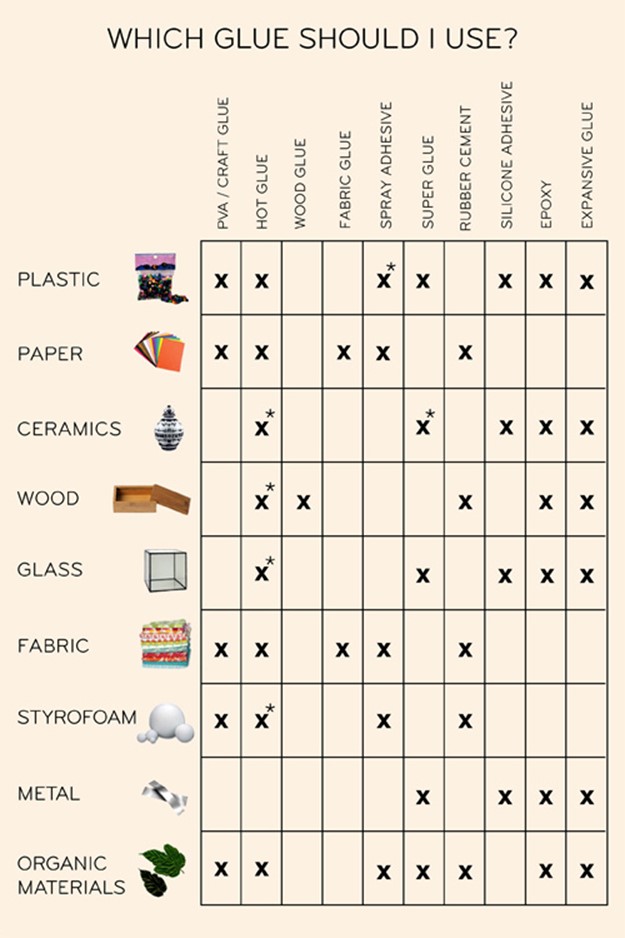




 Follow
Follow

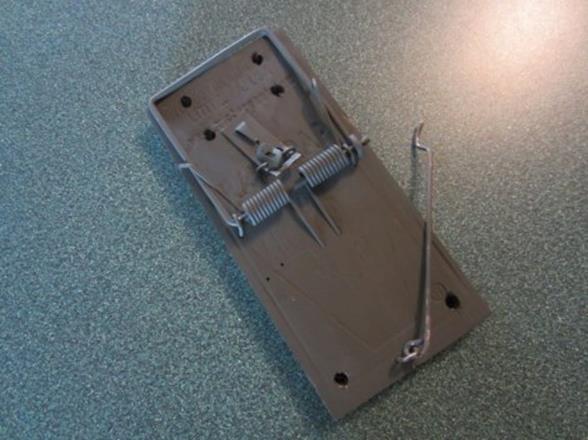
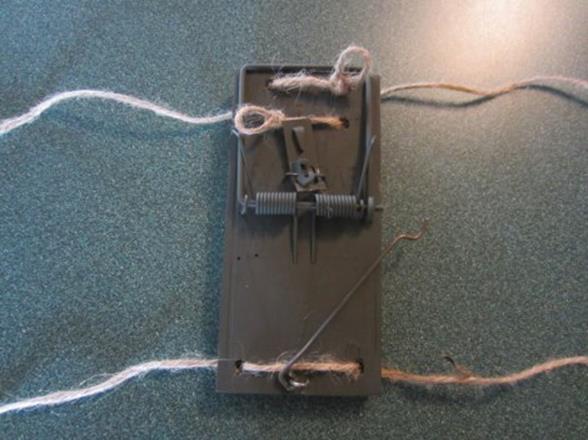
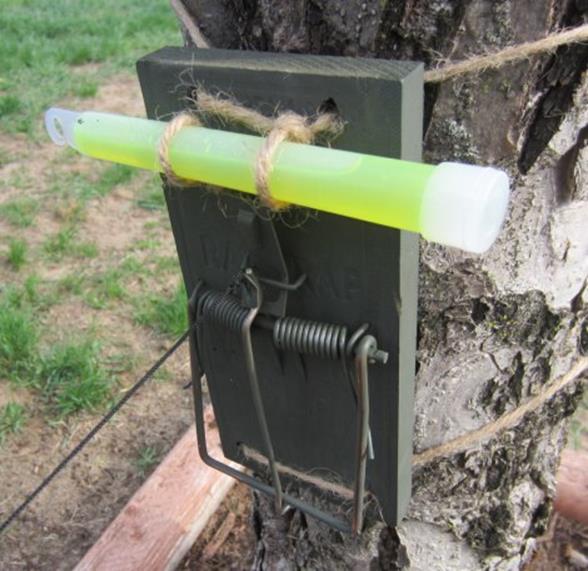
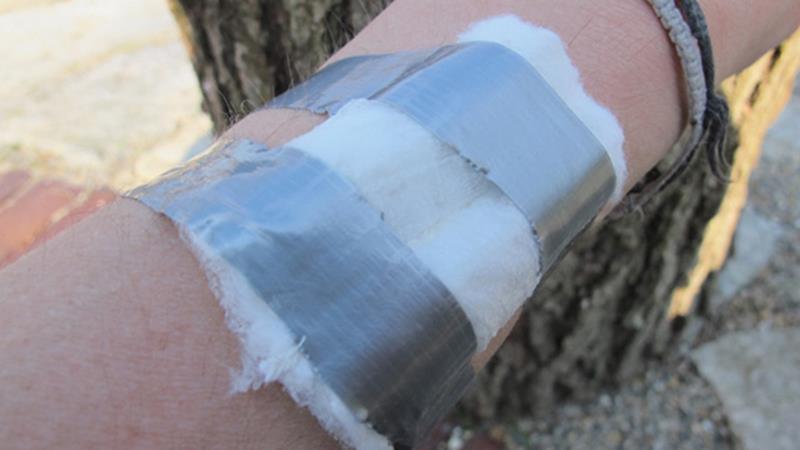
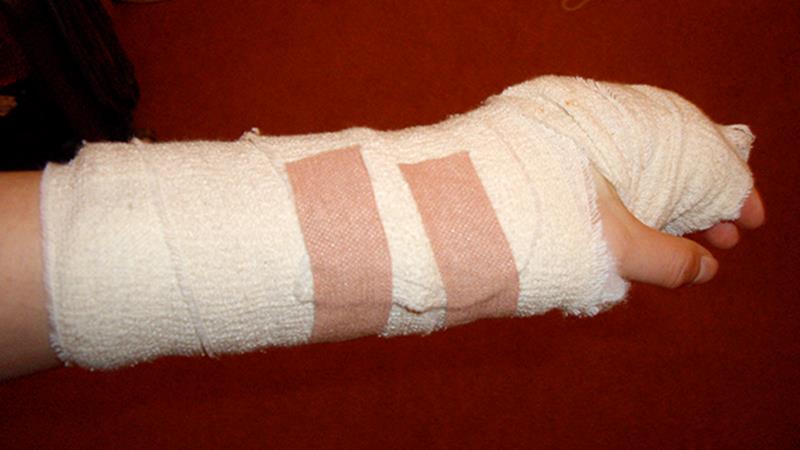
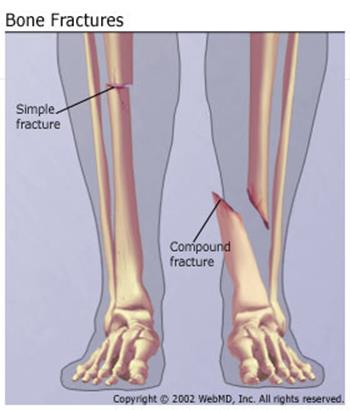
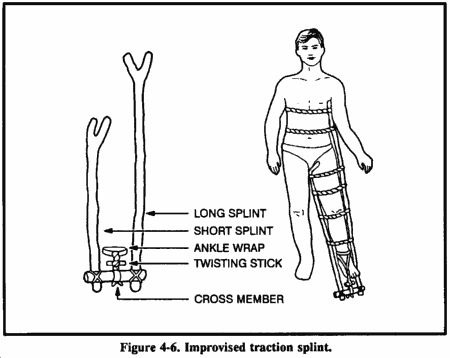
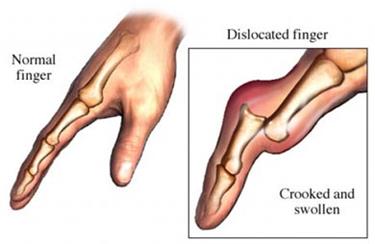 Dislocated bones are when bone joints have been separated. They can be very painful. They can push against nerve and blood vessels causing nerve tenderness and your circulatory system to have trouble.
Dislocated bones are when bone joints have been separated. They can be very painful. They can push against nerve and blood vessels causing nerve tenderness and your circulatory system to have trouble.